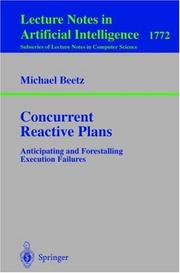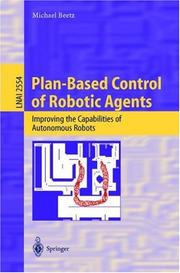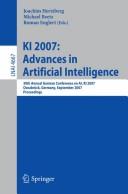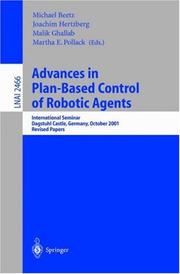| Listing 1 - 10 of 12 | << page >> |
Sort by
|

ISBN: 3540672419 3540464360 Year: 2000 Publisher: Berlin, Heidelberg : Springer Berlin Heidelberg : Imprint: Springer,
Abstract | Keywords | Export | Availability | Bookmark
 Loading...
Loading...Choose an application
- Reference Manager
- EndNote
- RefWorks (Direct export to RefWorks)
In this book, the author presents a new computational model of forestalling common flaws in autonomous robot behavior. To this end, robots are equipped with structured reactive plans (SRPs) which are concurrent control programs that can not only be interpreted but also be reasoned about and manipulated. The author develops a representation for SRPs in which declarative statements for goals, perceptions, and beliefs make the structure and purpose of SRPs explicit and thereby simplify and speed up reasoning about SRPs and their projections; furthermore a notation is introduced allowing for transforming and manipulating SRPs. Using this notation, a planning system can diagnose and forestall common flaws in robot plans that cannot be dealt with in other planning representations. Finally the language for writing SRPs is extended into a high-level language that can handle both planning and execution actions.
Autonomous robots --- Robots --- Mechanical Engineering - General --- Mechanical Engineering --- Engineering & Applied Sciences --- Control systems --- Control systems. --- Robot control --- Computer science. --- Computer communication systems. --- Computer logic. --- Artificial intelligence. --- Computer Science. --- Artificial Intelligence (incl. Robotics). --- Computer Communication Networks. --- Logics and Meanings of Programs. --- Robotics --- Logic design. --- Artificial Intelligence. --- AI (Artificial intelligence) --- Artificial thinking --- Electronic brains --- Intellectronics --- Intelligence, Artificial --- Intelligent machines --- Machine intelligence --- Thinking, Artificial --- Bionics --- Cognitive science --- Digital computer simulation --- Electronic data processing --- Logic machines --- Machine theory --- Self-organizing systems --- Simulation methods --- Fifth generation computers --- Neural computers --- Design, Logic --- Design of logic systems --- Digital electronics --- Electronic circuit design --- Logic circuits --- Switching theory --- Computer science logic --- Logic, Symbolic and mathematical --- Communication systems, Computer --- Computer communication systems --- Data networks, Computer --- ECNs (Electronic communication networks) --- Electronic communication networks --- Networks, Computer --- Teleprocessing networks --- Data transmission systems --- Digital communications --- Electronic systems --- Information networks --- Telecommunication --- Cyberinfrastructure --- Network computers --- Distributed processing

ISBN: 3540003355 3540363815 9783540003359 Year: 2002 Volume: 2554 Publisher: Berlin, Heidelberg : Springer Berlin Heidelberg : Imprint: Springer,
Abstract | Keywords | Export | Availability | Bookmark
 Loading...
Loading...Choose an application
- Reference Manager
- EndNote
- RefWorks (Direct export to RefWorks)
Robotic agents, such as autonomous office couriers or robot tourguides, must be both reliable and efficient. Thus, they have to flexibly interleave their tasks, exploit opportunities, quickly plan their course of action, and, if necessary, revise their intended activities. This book makes three major contributions to improving the capabilities of robotic agents: - first, a plan representation method is introduced which allows for specifying flexible and reliable behavior - second, probabilistic hybrid action models are presented as a realistic causal model for predicting the behavior generated by modern concurrent percept-driven robot plans - third, the system XFRMLEARN capable of learning structured symbolic navigation plans is described in detail.
Robots --- Autonomous robots --- Intelligent agents (Computer software) --- Intelligent control systems --- Control systems --- Autonomous robots. --- Intelligent control systems. --- Control systems. --- Intelligent control --- Intelligent controllers --- Agents, Autonomous (Computer software) --- Agents, Cognitive (Computer software) --- Agents, Intelligent (Computer software) --- Assistants, Cognitive (Computer software) --- Assistants, Intelligent software --- Autonomous agents (Computer software) --- Cognitive agents (Computer software) --- Cognitive assistants (Computer software) --- IAs (Computer software) --- Intelligent agent software --- Intelligent software agents --- Intelligent software assistants --- Software agents (Computer software) --- Special agents (Computer software) --- Autonomous robotic systems --- Robot control --- Engineering. --- Computer science. --- Computer communication systems. --- Special purpose computers. --- Artificial intelligence. --- Control engineering. --- Robotics. --- Mechatronics. --- Automation. --- Robotics and Automation. --- Artificial Intelligence (incl. Robotics). --- Computer Science, general. --- Computer Communication Networks. --- Special Purpose and Application-Based Systems. --- Control, Robotics, Mechatronics. --- Robotics --- Automatic control --- Artificial intelligence --- Computer programs --- Software engineering. --- Artificial Intelligence. --- AI (Artificial intelligence) --- Artificial thinking --- Electronic brains --- Intellectronics --- Intelligence, Artificial --- Intelligent machines --- Machine intelligence --- Thinking, Artificial --- Bionics --- Cognitive science --- Digital computer simulation --- Electronic data processing --- Logic machines --- Machine theory --- Self-organizing systems --- Simulation methods --- Fifth generation computers --- Neural computers --- Computer software engineering --- Engineering --- Informatics --- Science --- Mechanical engineering --- Microelectronics --- Microelectromechanical systems --- Control engineering --- Control equipment --- Control theory --- Engineering instruments --- Automation --- Programmable controllers --- Special purpose computers --- Computers --- Communication systems, Computer --- Computer communication systems --- Data networks, Computer --- ECNs (Electronic communication networks) --- Electronic communication networks --- Networks, Computer --- Teleprocessing networks --- Data transmission systems --- Digital communications --- Electronic systems --- Information networks --- Telecommunication --- Cyberinfrastructure --- Network computers --- Automatic factories --- Automatic production --- Computer control --- Engineering cybernetics --- Factories --- Industrial engineering --- Mechanization --- Assembly-line methods --- Automatic machinery --- CAD/CAM systems --- Distributed processing --- Robots - Control systems
Book
Year: 1978 Publisher: [West Germany? : : s.n.],
Abstract | Keywords | Export | Availability | Bookmark
 Loading...
Loading...Choose an application
- Reference Manager
- EndNote
- RefWorks (Direct export to RefWorks)
Voting --- Economic policy --- Vote --- Mathematical models. --- Political aspects --- Modèles mathématiques
Book
ISBN: 3319119729 3319119737 Year: 2014 Publisher: Cham : Springer International Publishing : Imprint: Springer,
Abstract | Keywords | Export | Availability | Bookmark
 Loading...
Loading...Choose an application
- Reference Manager
- EndNote
- RefWorks (Direct export to RefWorks)
This book constitutes the refereed proceedings of the 6th International Conference on Social Robotics, ICSR 2014, held in Sydney, NSW, Australia, in October 2014. The 41 revised full papers presented in this book were carefully reviewed and selected from numerous submissions. Amongst others, topics covered are such as interaction and collaboration among robots, humans, and environments; robots to assist the elderly and persons with disabilities; socially assistive robots to improve quality of life; affective and cognitive sciences for socially interactive robots; personal robots for the home; social acceptance and impact in the society; robot ethics in human society and legal implications; context awareness, expectation, and intention understanding; control architectures for social robotics; socially appealing design methodologies; safety in robots working in human spaces; human augmentation, rehabilitation, and medical robots; robot applications in education, entertainment, and gaming; knowledge representation and reasoning frameworks for robot social intelligence; cognitive architectures that support social intelligence for robots; robots in the workplace; human-robot interaction; creative and entertaining robots.
Computer science. --- User interfaces (Computer systems). --- Artificial intelligence. --- Computers and civilization. --- Robotics. --- Automation. --- Computer Science. --- Artificial Intelligence (incl. Robotics). --- Computers and Society. --- User Interfaces and Human Computer Interaction. --- Robotics and Automation. --- Artificial Intelligence. --- Informatics --- Science --- AI (Artificial intelligence) --- Artificial thinking --- Electronic brains --- Intellectronics --- Intelligence, Artificial --- Intelligent machines --- Machine intelligence --- Thinking, Artificial --- Bionics --- Cognitive science --- Digital computer simulation --- Electronic data processing --- Logic machines --- Machine theory --- Self-organizing systems --- Simulation methods --- Fifth generation computers --- Neural computers --- Artificial intelligence --- Computer science --- Research. --- Statistical methods --- Automatic factories --- Automatic production --- Computer control --- Engineering cybernetics --- Factories --- Industrial engineering --- Mechanization --- Assembly-line methods --- Automatic control --- Automatic machinery --- CAD/CAM systems --- Robotics --- Automation --- Interfaces, User (Computer systems) --- Human-machine systems --- Human-computer interaction --- Civilization and computers --- Civilization
Digital
ISBN: 9783540745655 Year: 2007 Publisher: Berlin, Heidelberg Springer-Verlag Berlin Heidelberg
Abstract | Keywords | Export | Availability | Bookmark
 Loading...
Loading...Choose an application
- Reference Manager
- EndNote
- RefWorks (Direct export to RefWorks)
Mathematical logic --- Information systems --- Artificial intelligence. Robotics. Simulation. Graphics --- Translation science --- Linguistics --- vertalen --- linguïstiek --- database management --- wiskunde --- logica --- robots
Book
Year: 2007 Publisher: Berlin Springer
Abstract | Keywords | Export | Availability | Bookmark
 Loading...
Loading...Choose an application
- Reference Manager
- EndNote
- RefWorks (Direct export to RefWorks)
Book
ISBN: 9783540745655 Year: 2007 Publisher: Berlin, Heidelberg Springer-Verlag Berlin Heidelberg
Abstract | Keywords | Export | Availability | Bookmark
 Loading...
Loading...Choose an application
- Reference Manager
- EndNote
- RefWorks (Direct export to RefWorks)
The 30th Annual German Conference on Arti?cial Intelligence (KI-2007) took place in the University of Osnabru ¨ck, September 10-13, 2007. In this volume, you will ?nd papers or abstracts of its six invited talks, 25 full papers, and 21 posters. The full papers were selected from 81 submissions, resulting in an acceptance rate of 32%. AsusualataKIconference,anentiredaywasreservedfortargetedworkshops - ten of them this year - and two tutorials. They are not coveredin this volume, but the conference Web sitewww.ki2007.uos.de will keep providing information and references to their contents. Some topic clusters are apparent in the overall conference program, which re?ect recent trends in AI research, convolved with foci of work in Germany and Europe. Examples are learning and data mining, robotics and perception, knowledge representation and reasoning, planning and search - all of them including a healthy number of approaches dealing with uncertainty, contradiction, and incompleteness of knowledge. All in all, KI-2007 provided a cross section of modern AI research and application work. KI-2007 also constituted a small anniversary, being the 30th exemplar of its kind. The invited talk by Wolfgang Bibel (accompanied by a paper in this volume) picked up on that occasion by recalling what the ?eld of automated deduction was like 30 and more years ago - in general, and in Germany. He also paid homage to Gerd Veenker, who organizedthe ?rst KI conference (which had a di?erent name at the time) in 1975 and whose ?eld of research was deduction.
Mathematical logic --- Information systems --- Artificial intelligence. Robotics. Simulation. Graphics --- Translation science --- Linguistics --- vertalen --- linguïstiek --- database management --- wiskunde --- logica --- robots
Multi
ISBN: 9783031060786 9783031060779 9783031060793 9783031060809 Year: 2022 Publisher: Cham Springer International Publishing
Abstract | Keywords | Export | Availability | Bookmark
 Loading...
Loading...Choose an application
- Reference Manager
- EndNote
- RefWorks (Direct export to RefWorks)
This book aims at sharing knowledge about the technological opportunities and the main research challenges regarding robotics for logistics in supermarkets and retail stores, from the perspectives of the end-users, logistic companies, technology providers, and robotic researchers. The authors have been involved into the H2020 project Robotics Enabling Fully Integrated Logistics Lines for Supermarkets (REFILLS), aimed at improving logistics in supermarkets thanks to mobile robotic systems in close and smart collaboration with humans. The readers will find a comprehensive analysis of the main logistic processes in retail stores with possible robotized solutions, involving mechanical design, perception, and control. These technologies have been validated in realistic environments, and some of them have been tested into real supermarkets. The book is intended for a broad academic and industrial readership, including operators in the field of logistics, distribution, and retail.
Methodology of economics --- Electrical engineering --- Engineering sciences. Technology --- Business management --- Business economics --- Artificial intelligence. Robotics. Simulation. Graphics --- Computer. Automation --- financieel management --- mechatronica --- industriële robots --- automatisering --- robots --- automatische regeltechniek

ISBN: 9783540745648 3540745645 3540745653 Year: 2007 Publisher: Berlin, Germany : Springer,
Abstract | Keywords | Export | Availability | Bookmark
 Loading...
Loading...Choose an application
- Reference Manager
- EndNote
- RefWorks (Direct export to RefWorks)
The 30th Annual German Conference on Arti?cial Intelligence (KI-2007) took place in the University of Osnabru ¨ck, September 10–13, 2007. In this volume, you will ?nd papers or abstracts of its six invited talks, 25 full papers, and 21 posters. The full papers were selected from 81 submissions, resulting in an acceptance rate of 32%. AsusualataKIconference,anentiredaywasreservedfortargetedworkshops – ten of them this year – and two tutorials. They are not coveredin this volume, but the conference Web sitewww.ki2007.uos.de will keep providing information and references to their contents. Some topic clusters are apparent in the overall conference program, which re?ect recent trends in AI research, convolved with foci of work in Germany and Europe. Examples are learning and data mining, robotics and perception, knowledge representation and reasoning, planning and search – all of them including a healthy number of approaches dealing with uncertainty, contradiction, and incompleteness of knowledge. All in all, KI-2007 provided a cross section of modern AI research and application work. KI-2007 also constituted a “small anniversary,” being the 30th exemplar of its kind. The invited talk by Wolfgang Bibel (accompanied by a paper in this volume) picked up on that occasion by recalling what the ?eld of automated deduction was like 30 and more years ago – in general, and in Germany. He also paid homage to Gerd Veenker, who organizedthe ?rst KI conference (which had a di?erent name at the time) in 1975 and whose ?eld of research was deduction.
Artificial intelligence --- Intelligence artificielle --- Congresses. --- Congrès --- Computer Science --- Mechanical Engineering - General --- Mechanical Engineering --- Engineering & Applied Sciences --- Information Technology --- Artificial Intelligence --- Self-organizing systems --- Computer science. --- Mathematical logic. --- Data mining. --- Artificial intelligence. --- Computational linguistics. --- Computer Science. --- Artificial Intelligence (incl. Robotics). --- Data Mining and Knowledge Discovery. --- Mathematical Logic and Formal Languages. --- Language Translation and Linguistics. --- Automatic language processing --- Language and languages --- Language data processing --- Linguistics --- Natural language processing (Linguistics) --- Applied linguistics --- Cross-language information retrieval --- Mathematical linguistics --- Multilingual computing --- AI (Artificial intelligence) --- Artificial thinking --- Electronic brains --- Intellectronics --- Intelligence, Artificial --- Intelligent machines --- Machine intelligence --- Thinking, Artificial --- Bionics --- Cognitive science --- Digital computer simulation --- Electronic data processing --- Logic machines --- Machine theory --- Simulation methods --- Fifth generation computers --- Neural computers --- Algorithmic knowledge discovery --- Factual data analysis --- KDD (Information retrieval) --- Knowledge discovery in data --- Knowledge discovery in databases --- Mining, Data --- Database searching --- Algebra of logic --- Logic, Universal --- Mathematical logic --- Symbolic and mathematical logic --- Symbolic logic --- Mathematics --- Algebra, Abstract --- Metamathematics --- Set theory --- Syllogism --- Informatics --- Science --- Data processing --- Natural language processing (Computer science). --- Artificial Intelligence. --- Natural Language Processing (NLP). --- NLP (Computer science) --- Human-computer interaction --- Semantic computing

ISBN: 3540377247 3540001689 Year: 2002 Publisher: Berlin, Heidelberg : Springer Berlin Heidelberg : Imprint: Springer,
Abstract | Keywords | Export | Availability | Bookmark
 Loading...
Loading...Choose an application
- Reference Manager
- EndNote
- RefWorks (Direct export to RefWorks)
In recent years, autonomous robots, including Xavier, Martha [1], Rhino [2,3], Minerva,and Remote Agent, have shown impressive performance in long-term demonstrations. In NASA’s Deep Space program, for example, an - tonomous spacecraft controller, called the Remote Agent [5], has autonomously performed a scienti?c experiment in space. At Carnegie Mellon University, Xavier [6], another autonomous mobile robot, navigated through an o?ce - vironment for more than a year, allowing people to issue navigation commands and monitor their execution via the Internet. In 1998, Minerva [7] acted for 13 days as a museum tourguide in the Smithsonian Museum, and led several thousand people through an exhibition. These autonomous robots have in common that they rely on plan-based c- trol in order to achieve better problem-solving competence. In the plan-based approach, robots generate control actions by maintaining and executing a plan that is e?ective and has a high expected utility with respect to the robots’ c- rent goals and beliefs. Plans are robot control programs that a robot can not only execute but also reason about and manipulate [4]. Thus, a plan-based c- troller is able to manage and adapt the robot’s intended course of action — the plan — while executing it and can thereby better achieve complex and changing tasks.
Robots --- Autonomous robots --- Intelligent agents (Computer software) --- Intelligent control systems --- Mechanical Engineering - General --- Mechanical Engineering --- Engineering & Applied Sciences --- Control systems --- Autonomous robotic systems --- Engineering. --- Computer science. --- Artificial intelligence. --- Control engineering. --- Robotics. --- Mechatronics. --- Automation. --- Robotics and Automation. --- Artificial Intelligence (incl. Robotics). --- Computer Science, general. --- Control, Robotics, Mechatronics. --- Artificial Intelligence. --- AI (Artificial intelligence) --- Artificial thinking --- Electronic brains --- Intellectronics --- Intelligence, Artificial --- Intelligent machines --- Machine intelligence --- Thinking, Artificial --- Bionics --- Cognitive science --- Digital computer simulation --- Electronic data processing --- Logic machines --- Machine theory --- Self-organizing systems --- Simulation methods --- Fifth generation computers --- Neural computers --- Informatics --- Science --- Mechanical engineering --- Microelectronics --- Microelectromechanical systems --- Control engineering --- Control equipment --- Control theory --- Engineering instruments --- Automation --- Programmable controllers --- Automatic factories --- Automatic production --- Computer control --- Engineering cybernetics --- Factories --- Industrial engineering --- Mechanization --- Assembly-line methods --- Automatic control --- Automatic machinery --- CAD/CAM systems --- Robotics
| Listing 1 - 10 of 12 | << page >> |
Sort by
|

 Search
Search Feedback
Feedback About UniCat
About UniCat  Help
Help News
News